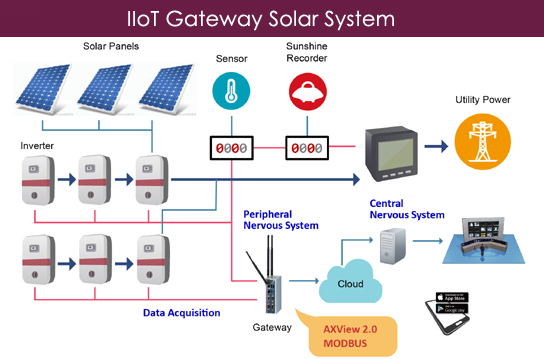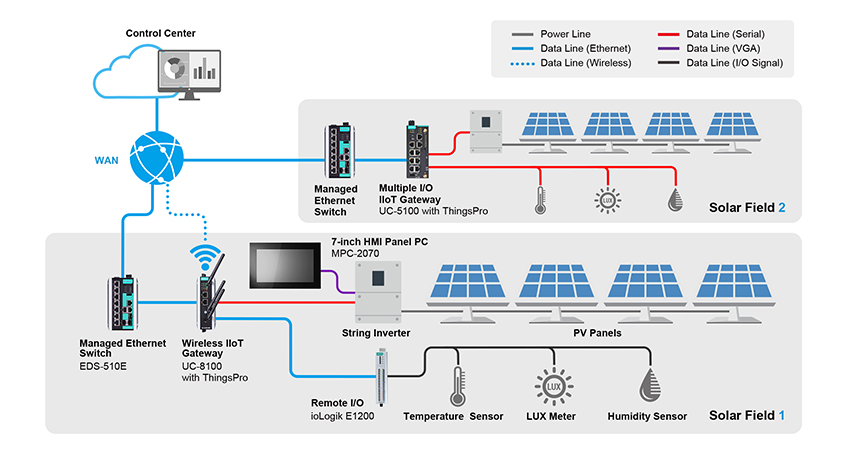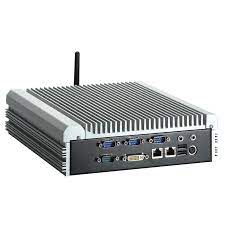In order to mitigate the effects of global warming, many countries have made ambitious plans to invest in different forms of renewable energy in Embedded Systems, including the use of photovoltaic (PV) solar energy systems. According to an estimate from International Energy Agency (IEA), PV solar electricity will become the leading source of energy in the near future.
Since most PV stations are unmanned and dispersed geographically in suburban areas, the computer system that monitors the operations equipment and devices is extremely important. Intelligent systems play a mission-critical role in solar power utility applications.
One of Axiomtek’s customers selected the ICO300 controller, combined with Axiomtek’s remote management AXView 2.0 software, to monitor the status of their solar modules and inverters as a predictive maintenance solution. The ICO300 was purposely integrated as a gateway controller and used to transfer the solar station’s operational data through the cloud to the control center for analysis. The main goal is to use the analytical results to improve operational efficiency. This report is then made available for further actions on their website portal.

Infrastructure Features
In addition to being a power generation system provider, Axiomtek’s customer also manufactures solar cells and solar module products while also rendering related services. This customer has accumulated a great deal of power plant implementation and development experience including flat-roof type and pitched-roof type solar systems in Embedded Systems.
Challenges
1. PV solar power generation stations are dispersed geographically with no IT personnel on-site to maintain the technical issues. In order to maintain reliable operation, a decentralized intelligent monitoring system with centralized control is required.
2. Network connectivity, such as 4G, is required to make data collection and remote management feasible in order to have real-time data shown in the station’s control room.
3. Most of these intelligent systems collecting data from devices or sensors are placed in harsh environments, so they have to be specifically designed to operate in extreme temperatures and wet/dusty conditions.
4. Built-in intelligent management software is needed in order to help the customer shorten their time to market and reduce development time.
In this case, the customer built a PV solar power station based on a grid-connected PV structure. Many solar panels are combined together to create one solar array are then connected to PV inverters which convert the variable direct current (DC) output of a PV solar panel into a utility frequency alternating current (AC), which can be fed into a commercial electrical grid or used by a local network. Embedded Computer systems also have thermal sensors and pyrometers installed to detect the surrounding environment and a smart meter to record the output volume of the power generation station.
For this application, the customer used Axiomtek’s ICO300, with the AXView 2.0 software, as an intelligent IoT device to record and collect the data for all of its connected devices and sensors. The customer also connected PV inverters and smart meters via RS-485 (using a daisy chain wiring scheme) and used the Modbus protocol (which is a serial communication protocol and a commonly available means of connecting industrial electronic devices). Real-time data was retrieved by ICO300 via RS-485. Aside from acting as a data acquisition system, the ICO300 also plays the role of an Industrial IoT gateway. Utilizing the “cloud agent” program, the intelligent system can forward any collected data using Simple Object Access Protocol (SOAP), a known protocol specification for exchanging structured information in the implementation of web services in computer networks.
Axiomtek’s AXView 2.0 is a software service that can monitor the ICO300 behavior; trigger event alerts when abnormalities occur and share machine information with other remote management systems and the service cloud.
The data is collected and forwarded to the cloud to be processed and analyzed at a control center. The customer also has a monitoring portal for its end-users, allowing them to view real-time data such as the daily power generation volume and the performance of the PV inverters. This data can be accessed via a mobile phone or on a tablet for their convenience.
Since on-site preventive maintenance service is very costly and takes a lot of time, this monitoring system also implements predictive maintenance service for solar panels. By analyzing the operational data from PV inverters, sensors, and smart meters in the cloud, the monitoring system can predict when each device is going to break down so that the system can send a Short Message Service (SMS) to a technician to eliminate the downtime associated with a faulty device.
System Design Features
Axiomtek ICO300 offers a fanless, rugged design and utilizes the low power consumption and most advanced 22nm Intel® Atom™ processor E3815 (1.46 GHz) in the market. It supports DDR3L system memory of up to 4GB. This Intel® IoT gateway solution is feature-rich, with expansive wireless connectivity options including one full-size PCI Express Mini Card, one SIM socket, four RS-232/422/485 ports, and two isolated Gigabit Ethernet ports. Other features include two high-speed USB 2.0 ports, RTC battery function, and wide voltage range 12V – 24V DC power input with terminal block. Since PV solar stations are often located outdoors, the ICO300 supports an extended operating temperature range of -20°C to +70°C to ensure reliable operation in harsh weather environments. The reliable ICO300 Embedded Systems with a industrial monitor is a perfect solution for IoT, industrial, and embedded applications such as PV solar power generation stations, facility monitoring systems, and other challenging operations in harsh environments.

AXView 2.0
Axiomtek’s AXView 2.0 software comes with cloud service and M2M protocols. Embedded Rackmount PCs are highly integrated software management system that provides remote management architecture and an easy-to-use application programming interface.

Local Hardware Monitoring Service Agent
The agent is a software service that monitors local hardware devices, sends alerts, and shares device health information through remote management systems when abnormalities happen.
Remote Management System
The remote management system is an alert receiver. Users can enter the service cloud by keying in their IP address to connect to the cloud. Once connected, any event alert sent by the local hardware monitoring service agent will be pushed to your phablet automatically.
Service Cloud
The Service Cloud is a new AXView 2.0 feature compared to version 1.0. It can store, forward and review machine health information for behavior analysis. AXView 2.0 also provides software packages to assist users in constructing their own cloud.
EAPI
AXView 2.0 supports Fanless Embedded PCs Application Programming Interface (EAPI) compliance with PICMG EAPI standards and extends its features to support access to special system information, hardware health status, system behavior, and unique system designs such as battery backup memory area, panel backlight, DIO, and dual hardware watchdogs.




